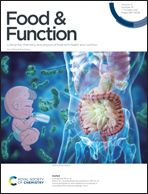Influence of Sargassum pallidum and the synergistic interaction mechanism of 6-gingerol and poricoic acid A on inhibiting ovalbumin glycation
Abstract
This study aimed to investigate the antiglycation capacity of Sargassum pallidum extract on ovalbumin (OVA) glycation, and the interaction mechanism of its active compounds, including 6-gingerol (6G) and poricoic acid A (PA). The results showed that Sargassum pallidum extract, PA and 6G had excellent suppression on the formation of fructosamine, 5-hydroxymethylfurfural (5-HMF), acrylamide and advanced glycation end products (AGEs), which was higher than aminoguanidine (AG). The combination of PA and 6G showed good synergistic effect on inhibiting the formation of AGEs. PA exhibited the strongest inhibition activity for protein glycation products, and the content of 5-HMF and acrylamide decreased from 277.44 and 10.60 μg mL−1 to 208.37 and 5.46 μg mL−1, respectively, at 30.08 × 10−5 M compared with the control group. 6G and PA quenched the fluorescence of OVA with a static mechanism, and enhanced the hydrophilic microenvironment of the tyrosine (Tyr) and tryptophan (Trp) residues. The binding of 6G and PA with OVA was spontaneous and driven by hydrogen bonds and van der Waals interactions. Molecular docking indicated that 6G and PA entered the hydrophobic cavity of OVA, and formed hydrogen bonds with Ser103, Leu101 and Thr 91. These findings suggested that Sargassum pallidum extract, PA and 6G have great potential as antiglycation inhibitors to treat diabetes complications in healthy food.



 Please wait while we load your content...
Please wait while we load your content...